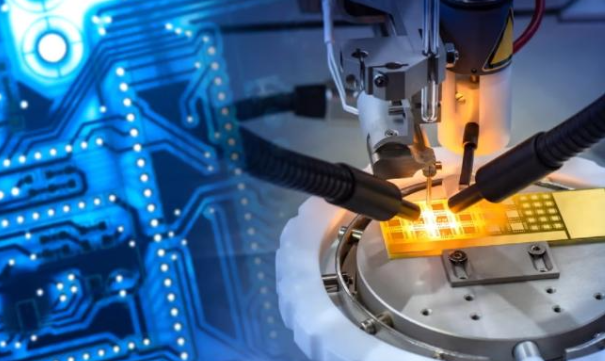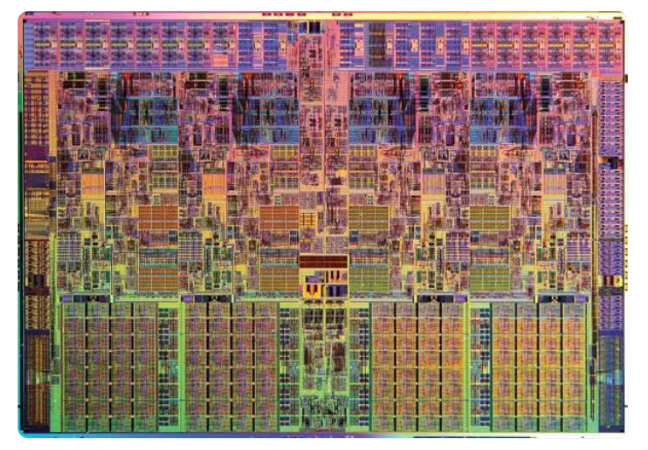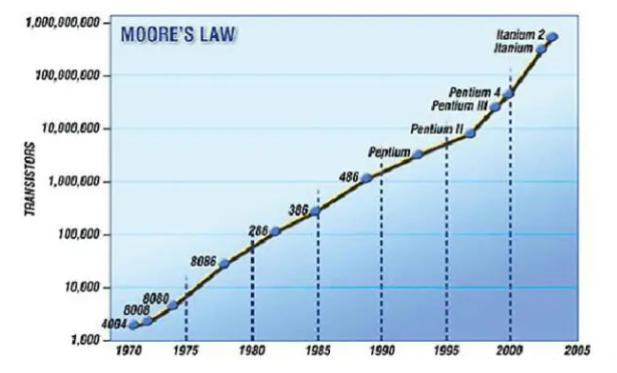2月 20, 2024
1636

One way to measure how good and powerful a computer's brain (CPU) is, is by counting the tiny switches inside it called transistors. Transistors are like the building blocks of computing. They help the CPU do all sorts of tasks by turning on and off to handle information.
The number of transistors in a CPU depends on a few things like how the CPU is designed, how many parts it has, and how new it is. Some CPUs have millions of transistors, while others have billions.
These transistors are like the workers in the CPU, helping it to do more tasks and work faster. As technology gets better, engineers find ways to fit more transistors into CPUs, making them more powerful but also smaller and more energy-efficient. So, the more transistors a CPU has, the better it can do its job!

The evolution of CPU technology over the decades has been nothing short of remarkable, with the transistor count serving as a tangible measure of the exponential growth in computational power. Following Moore's Law, which predicts a doubling of transistor count approximately every two years, CPUs have undergone a dramatic increase in transistor density, enabling unprecedented levels of performance and functionality.
Let's take a journey through time to explore how the transistor count in CPUs has skyrocketed over the years:

Intel 4004 (1971): The pioneering Intel 4004, widely regarded as the world's first microprocessor, heralded the dawn of the digital age with a modest 2,300 transistors. Despite its humble transistor count, the 4004 laid the groundwork for the microprocessor revolution that would follow.
Motorola 68000 (1979): The debut of the Motorola 68000 marked a significant milestone in CPU history, introducing the world to the power of 32-bit computing. With a transistor count of 68,000, the 68000 epitomized the transition towards higher computational complexity and performance.
MIPS R4000 (1991): The advent of the MIPS R4000 ushered in the era of 64-bit computing, boasting a formidable 1.35 million transistors. This leap in transistor density paved the way for enhanced processing capabilities and paved the way for future advancements in CPU architecture.
Intel Pentium (1993): The iconic Intel Pentium, released in 1993, showcased the rapid pace of innovation with its 3.1 million transistors. As the flagship CPU of its time, the Pentium solidified Intel's dominance in the microprocessor market and set new performance benchmarks.
AMD Athlon 64 X2 (2005): The introduction of the AMD Athlon 64 X2 marked a paradigm shift with its groundbreaking dual-core architecture, featuring an impressive 233.2 million transistors. This innovation heralded a new era of multi-core computing, enabling simultaneous execution of multiple tasks for enhanced productivity and performance.
Intel Core 2 Quad (2006): Intel's Core 2 Quad, unveiled in 2006, further pushed the boundaries of multi-core processing with its quad-core design, boasting 582 million transistors. This leap in transistor count facilitated unparalleled levels of multitasking and computational throughput.
Intel Core i7-980X (2010): The Intel Core i7-980X epitomized the pinnacle of desktop computing with its hexa-core configuration, featuring a staggering 1.17 billion transistors. This milestone underscored Intel's commitment to pushing the envelope of performance and scalability.
AMD FX-8150 (2011): AMD's FX-8150, released in 2011, showcased the company's prowess in multi-core processing with its octa-core design, boasting 1.2 billion transistors. This groundbreaking CPU redefined the performance landscape, offering unprecedented levels of parallelism and computing power.
Intel Core i7-6950X (2016): The Intel Core i7-6950X epitomized the epitome of desktop computing with its deca-core architecture, featuring an impressive 3.2 billion transistors. This monumental leap in transistor density unlocked new realms of performance and scalability, catering to the demands of enthusiasts and professionals alike.
AMD Ryzen Threadripper 1920X (2017): The introduction of AMD's Ryzen Threadripper 1920X marked a watershed moment in CPU innovation with its dodeca-core design, boasting 9.6 billion transistors. This revolutionary CPU redefined the boundaries of multi-core processing, delivering unprecedented levels of performance and efficiency.
AMD Ryzen Threadripper 1950X (2017): Building upon the success of its predecessor, the AMD Ryzen Threadripper 1950X introduced a hexadecachore configuration, featuring an astonishing 19.2 billion transistors. This quantum leap in transistor density heralded a new era of computational prowess, empowering users with unrivaled levels of multitasking and productivity.
Intel Core i9-7980XE (2017): Intel's Core i9-7980XE exemplified the pinnacle of enthusiast computing with its octodeca-core architecture, boasting 6.5 billion transistors. This monumental achievement underscored Intel's commitment to pushing the boundaries of performance and scalability, catering to the demands of content creators and power users.
Intel Xeon W-3175X (2019): The Intel Xeon W-3175X marked a paradigm shift in workstation computing with its vigintioctacore design, featuring 8.6 billion transistors. This groundbreaking CPU redefined the performance landscape, offering unparalleled levels of parallelism and compute power for professional workloads.
AMD Ryzen Threadripper 2990WX (2018): The AMD Ryzen Threadripper 2990WX exemplified the zenith of multi-core processing with its trigintiduo-core configuration, boasting 19.2 billion transistors. This monumental leap in transistor density unlocked unprecedented levels of performance and scalability, catering to the demands of content creators, developers, and enthusiasts alike.
AMD Ryzen Threadripper 3990X (2020): The AMD Ryzen Threadripper 3990X epitomized the pinnacle of desktop computing with its quadraginti-quad-core architecture, boasting an astounding 39.54 billion transistors. This revolutionary CPU redefined the boundaries of computational capability, delivering unparalleled levels of performance and efficiency for the most demanding workloads and applications.
However, it's crucial to acknowledge that while the transistor count in CPUs has witnessed exponential growth in adherence to Moore's Law over the years, this trajectory may encounter limitations in the foreseeable future. Physiological and practical constraints dictate the maximum size and density of transistors that can be feasibly integrated onto a chip. Consequently, CPU designers are compelled to explore alternative avenues for driving advancements in CPU performance and capabilities beyond mere transistor scaling. This necessitates a paradigm shift towards innovative design strategies, novel materials, and transformative computing paradigms to sustain and propel the trajectory of CPU evolution in the years to come.
In the realm of CPUs, transistors function as the building blocks that power the intricate machinery of data processing and storage. These tiny electronic devices, when arranged in specific configurations, form the backbone of logic gates and memory cells within the CPU.
The operation of transistors within a CPU hinges on their ability to control the flow of electrical current. By toggling between two states—commonly referred to as "on" and "off"—transistors can regulate the movement of electrical charge through a circuit. This pivotal capability enables transistors to execute Boolean logic operations, including AND, OR, and NOT functions, which are fundamental to processing and manipulating data within the CPU.
When transistors are configured within logic gates, they collectively enable the CPU to perform logical operations on binary inputs, producing corresponding output signals based on predetermined rules. For instance, in an AND gate configuration, the output is "on" only when all input signals are "on," representing a logical conjunction operation. Similarly, OR gates produce an "on" output if any of the input signals are "on," while NOT gates invert the input signal.
Furthermore, transistors also play a crucial role in the construction of memory cells within the CPU. These memory cells store binary data in the form of electrical charges, representing either a "0" or a "1" in the binary numeral system. Transistors within memory cells facilitate the writing, reading, and retention of data, ensuring swift and reliable access to information during CPU operations.
In essence, the operation of transistors within a CPU is characterized by their ability to modulate electrical current, enabling the execution of logical operations and the storage of binary data. Through their intricate interplay within logic gates and memory cells, transistors empower CPUs to process information efficiently and execute complex computational tasks with remarkable speed and accuracy.
The number of transistors in a CPU, a crucial indicator of its computational power and efficiency, is influenced by a multitude of factors, each contributing to the intricate architecture and performance of the processor.
The CPU's architecture delineates its fundamental design principles and dictates how it processes instructions. Modern CPUs typically adhere to either 64-bit or 32-bit architectures, each characterized by its capability to handle different data sizes and instructions. The choice of architecture profoundly impacts the transistor count, with 64-bit architectures typically requiring more transistors to handle larger data sets and execute complex instructions compared to their 32-bit counterparts.
The number of cores within a CPU, representing discrete processing units, directly influences its transistor count and computational capabilities. CPUs can feature a single core or multiple cores, such as dual-core, quad-core, or even higher configurations. Each core necessitates a significant allocation of transistors to execute instructions concurrently, enabling the CPU to perform multiple tasks simultaneously and enhance overall processing throughput.
The CPU's Thermal Design Power (TDP) signifies the maximum amount of power it consumes under theoretical maximum load. As the workload increases, so does the heat generated by the CPU, necessitating robust cooling solutions to prevent overheating. Transistors play a crucial role in managing this thermal output, with more complex CPUs requiring additional transistors to optimize thermal dissipation and maintain operational stability under varying workloads.
Clock speed, denoting the frequency at which the CPU executes instructions, is another determinant of transistor count. Higher clock speeds entail a greater number of transistors to facilitate rapid data processing and execution of instructions. CPUs with higher clock speeds boast enhanced computational performance, underpinned by a larger complement of transistors enabling swift data processing and execution of instructions.
The manufacturing process employed by CPU manufacturers significantly influences transistor density and overall performance. Advanced fabrication technologies enable the integration of a higher number of transistors onto a single chip, enhancing computational power and efficiency. However, the adoption of cutting-edge manufacturing processes entails increased production costs, prompting manufacturers to strike a balance between transistor density, performance, and cost-effectiveness.
Additional features, such as integrated graphics processing units (GPUs) or specialized accelerators, contribute to the transistor count of a CPU. Integration of GPUs within the CPU package necessitates additional transistors to support graphics rendering and parallel processing tasks, expanding the CPU's versatility and capabilities.
In summary, the number of transistors in a CPU is a multifaceted metric influenced by architectural design, core count, thermal considerations, clock speed, manufacturing processes, and additional features. By meticulously balancing these factors, CPU manufacturers strive to deliver processors with optimal performance, efficiency, and versatility across a diverse range of computing applications.
How many transistors are in the i9 processor?
The Intel Core i9 processors, depending on the specific model and generation, can vary in transistor count. However, as of recent generations, such as the 10th and 11th generations, the transistor count for certain Intel Core i9 processors is estimated to be around 10 billion transistors. It's essential to note that transistor counts can vary between different models and generations of the Intel Core i9 lineup, so the actual number of transistors may differ based on the specific CPU model.
How many transistors are in the average PC?
The total number of transistors in an average PC can be measured in billions, with variations based on factors like CPU model, RAM capacity, GPU model, and storage configuration. This illustrates the complexity and sophistication of modern PC hardware, which relies heavily on transistor-based semiconductor technology to deliver high-performance computing capabilities.
Which CPU has the most transistors?
Cerebras Systems' Wafer Scale Engine 2 (WSE-2) is indeed one of the processors with the highest transistor count. With a staggering 2.6 trillion transistors packed onto a single wafer-scale chip, the WSE-2 represents a monumental leap in computational power and transistor density.
Utilizing a cutting-edge 7 nm process node and boasting a transistor density of 1.5 trillion transistors per square meter, the WSE-2 epitomizes the pinnacle of semiconductor technology. Its innovative wafer-scale design, comprising 84 exposed fields (dies) seamlessly integrated into a single chip, enables unparalleled performance and efficiency in handling complex computational workloads, particularly in the realm of artificial intelligence and machine learning.
How big is a transistor in a modern CPU?
Indeed, the size of transistors in modern CPUs has been steadily shrinking over the years, driven by advancements in semiconductor manufacturing technology. The channel length of transistors in recent CPUs has reached as small as 5 nanometers (nm), representing a significant milestone in miniaturization and density improvement.
Just two years ago, the industry standard for transistor size was around 7nm, highlighting the rapid pace of technological progress in semiconductor fabrication. This reduction in transistor size has been a cornerstone of Moore's Law, which predicts that the number of transistors on a microchip will double approximately every two years. Over the past five decades, the semiconductor industry has consistently adhered to Moore's Law, continually shrinking transistor sizes from approximately 10 micrometers (um) to the current 5nm scale.
How many transistors in a 1tb SSD?
About 3 trillion transistors.
How many transistors does a cell phone have?
Modern smartphones are powered by highly advanced processors that contain a significant number of transistors. An average smartphone processor today can incorporate approximately 10 billion transistors. This substantial transistor count reflects the sophistication and computational power required to support a wide range of functionalities and applications on modern mobile devices.
How many transistors does a GPU have?
Modern GPUs (Graphics Processing Units) are characterized by their impressive transistor counts, which are essential for powering graphics-intensive tasks such as gaming, rendering, and artificial intelligence.
RTX 3090 Ti: This GPU model is reported to contain approximately 28.3 billion transistors. The high transistor count enables the RTX 3090 Ti to deliver exceptional graphics performance and support advanced features such as real-time ray tracing and AI-based rendering.
RTX 4090 Ti: While specific details may vary depending on the actual product release, it's anticipated that the RTX 4090 Ti will have an even higher transistor count, likely around 52 billion transistors. This significant increase in transistor count compared to previous generations reflects advancements in GPU architecture and manufacturing processes, enabling enhanced performance and capabilities for demanding applications.